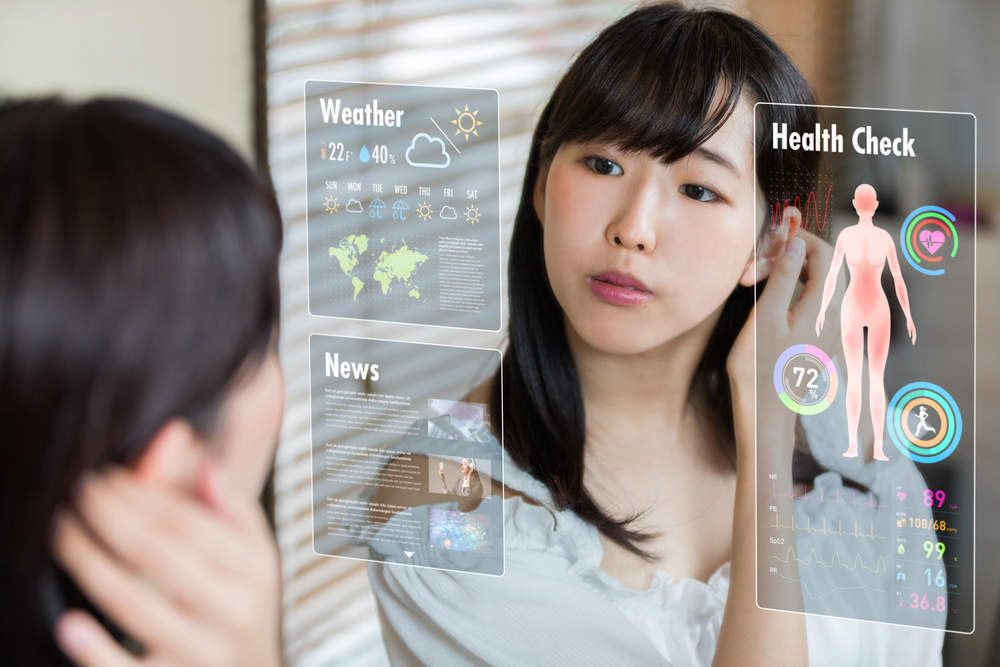
Once the stuff of science fiction, smart mirrors are now a reality. With virtual assistants now commonplace, smart technology is integrated into numerous devices throughout the home from thermostats to lighting and now even your reflection.
A smart mirror is a two-way mirror with cameras, electronic displays and sensors behind the glass. Most smart mirrors on the market today act as an extension of a smartphone, allowing users to browse social media feeds and view information such as the weather, the news or a daily calendar.
However, as technology advances, facial recognition software and augmented reality are already pushing the capabilities of smart mirrors even further. In January, Google published a patent application for a smart mirror that uses optical sensors to monitor users’ cardiovascular health by tracking changes in appearance linked to heart disease.
The HiMirror, which has been available to buy since 2016, analyses your complexion and gives make-up tips and products to buy based on the results.
Perhaps less flattering, Panasonic has developed a smart mirror which analyses the user’s face, including identifying wrinkles and blemishes, and gives tips on how to cover them.
Smart Mirrors in Retail
According to research by retail consultant Paco Underhill, 71% of customers who try something on in a fitting room will go on to buy something, making the fitting room a space which retailers can utilise to boost sales.
How well do you really know your competitors?
Access the most comprehensive Company Profiles on the market, powered by GlobalData. Save hours of research. Gain competitive edge.

Thank you!
Your download email will arrive shortly
Not ready to buy yet? Download a free sample
We are confident about the unique quality of our Company Profiles. However, we want you to make the most beneficial decision for your business, so we offer a free sample that you can download by submitting the below form
By GlobalDataSome retailers are experimenting with different ways to engage with customers in this area, with some flagship stores featuring smart mirrors that can scan clothes tags, allow shoppers to alert sales assistants, offer user-specific suggestions and change light levels to demonstrate what clothing will look like in different settings.
Last week, clothes retailer Zara announced that its new flagship store in Stratford will feature smart mirrors equipped with radio frequency identification that will suggest other items for a customer to buy based on what they are trying on.
US department store Saks Fifth Avenue also recently stated that it had introduced ‘magic mirrors’ for customers to virtually try on cosmetics products instore.
Companies such as Californian-based MemoMi are taking the capabilities of smart mirrors one step further. Their MemoryMirror uses augmented reality to display a projection of items of clothing onto the user’s reflection, making it possible for users to virtually ‘try on’ clothes without taking off what they are already wearing.
Marketing gimmick or here to stay?
According to Market Insights Reports, the global smart mirror market is predicted to grow at a CAGR of 10%-15% from 2018 to 2023. The market is expected to reach $1.2bn by 2022, from an estimated value of $386.8m in 2015, with innovations in the retail and automobile sectors expected to drive this growth.
However, the report highlights that the high implementation cost of smart mirrors and either a relatively low or a total lack of awareness among people regarding smart mirror technology are restraining the growth of the market to some extent.
Managing director of global technology consultancy DataArt Dmitry Bagrov warns that caution must be exercised in this area to ensure that technology does not take away from user experience:
“Technology should first and foremost provide consistency and continuity in experience. Luxury brands are the best positioned to invest in technology to create optimal experiences for its customers, whether that be through the use of virtual reality (VR), artificial intelligence (AI) or blockchain technologies. Brands just have to do it right. Customer first, technology second.
“The influence of AI, AR and VR is overestimated. There are compelling use-cases for what AI can solve outside of the retail sector in healthcare and finance and it remains to be seen how the technology can transform retail. AI requires a large amount of personal data and giving that data access away exposes the customer. It’s wishful thinking that AI is the ultimate solution. Introducing technology won’t change things magically, you need to tackle the problem first.”
However, with same-day deliveries becoming increasingly common, customers are starting to expect instant gratification when it comes to retail. Embracing cutting-edge technology to improve and speed-up the customer shopping experience may be the only way for retail stores to compete with their online counterparts.
Although it will likely be a while before every high street store features a smart mirror, with most currently only existing in flagship stores, customers are open to smart mirrors being used in some capacity, according to a survey conducted by SOTI. Their research suggests that two-thirds of consumers are more likely to shop at a store that integrates technology into the shopper experience.




